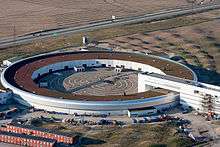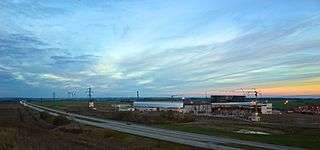MAX IV
Coordinates: 55°43′39″N 13°13′59″E / 55.72737°N 13.23298°E


MAX IV is the next-generation synchrotron radiation facility in Lund, Sweden. It is the strongest of its kind in the world.[1] Its design and planning has been carried out within the Swedish national laboratory, MAX-lab, which up until 2015 operated three accelerators for synchrotron radiation research. MAX I (550 MeV, opened 1986), MAX II (1,5 GeV, opened 1997) and MAX III (700 MeV, opened 2008). MAX-lab supported about 1000 users from over 30 countries annually. The facility operated 14 beamlines with a total of 19 independent experimental stations, supporting a wide range of experimental techniques such as macromolecular crystallography, electron spectroscopy, nanolithography and production of tagged photons for photo-nuclear experiments. The facility closed on the 13th of December (St Lucia dagen) 2015 in preparation for MAX IV.
On 27 April 2009 the Swedish Ministry of Education and Research, Swedish Research Council, Lund University, Region Skåne and Vinnova, a Swedish government funding agency, decided to fund the research center.[2]
The construction site of MAX IV,[3] on the fields of Brunnshög in Lund North East, has been opened in 2010. The new laboratories, including two storage rings and a full-energy linac, will be built here. The larger of the two storage rings has a circumference of 528 meters, operates at 3 GeV energy, and has been optimized for high-brightness x-rays.[4] The smaller storage ring (circumference 96 meters) is operated at 1.5 GeV energy and has been optimized for UV.[4] There are also plans for a future expansion of the facility that would add a free-electron laser (FEL) to the facility, but is yet to be funded.[2]
The inauguration of MAX IV took place 21 June 2016, on the day of summer solstice.[5] At this point the 3 GeV ring along with the first few beam-lines was opened for users to start their experiments. The smaller storage ring will not be opened until later that year.
See also
References
- ↑ http://www.teknat.umu.se/pressinformation/nyhetsvisning/varldens-starkaste-synkrotron-invigs.cid270740
- 1 2 "The MAX IV Project". MAX-lab. Retrieved 2013-02-28.
- ↑ "MAX IV Construction website". ML4 AB. Retrieved 2013-02-28.
- 1 2 "Accelerators – MAX IV". www.maxiv.lu.se. Retrieved 2016-08-11.
- ↑ "MAX IV Laboratory | We make the invisible visible". www.maxlab.lu.se. Retrieved 2015-12-15.
External links
- Website of the MAX IV Laboratory
- Webcam of the MAX IV construction site
- Lightsources.org, information about the world’s synchrotron and free electron laser light source facilities
- International evaluation of the MAX IV concept (2006), in .pdf format